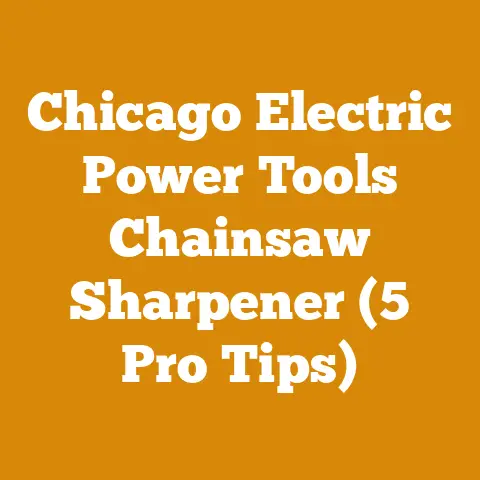Echo CS 310 Chain Replacement Tips (5 Pro Arborist Secrets)
Introduction: Echo CS-310 Chain Replacement – A Pro Arborist’s Secrets (and a Nod to Our Furry Friends)
As a seasoned arborist, I’ve spent countless hours in the field, felling trees, limbing branches, and bucking logs.
My Echo CS-310 has been a trusty companion through it all.
It’s a reliable little saw, perfect for smaller jobs and limbing, but like any tool, it requires regular maintenance, especially chain replacement.
And while I’m deeply immersed in the world of wood, I’m also a huge animal lover.
So, before we dive into the nitty-gritty of chain replacement, let’s acknowledge something crucial: responsible forestry and wood processing also means being mindful of the local ecosystem.
That includes choosing pet-friendly bar and chain oil.
Petroleum-based oils can be toxic if ingested, and our furry friends are often curious about the tools we use.
Opt for vegetable-based or synthetic biodegradable oils.
They’re not only better for the environment but also safer for your pets.
Now, let’s get to the heart of the matter: replacing the chain on your Echo CS-310.
It’s a skill every chainsaw owner should master.
It saves time, money, and ensures your saw is always performing at its best.
I’m going to share five “pro arborist secrets” that will make the process smoother, safer, and more efficient.
These aren’t just theoretical tips; they’re lessons learned from years of experience.
Why Chain Replacement Matters: More Than Just Sharpness
Before we get into the how-to, let’s briefly discuss the why.
A dull or damaged chain isn’t just inefficient; it’s dangerous.
- Increased Kickback Risk: A dull chain requires more force to cut, increasing the likelihood of kickback, where the saw suddenly jumps back toward the operator.
- Overheating: A dull chain creates more friction, leading to overheating of the bar and chain, potentially damaging the saw.
- Increased Wear and Tear: Forcing a dull chain to cut puts extra strain on the engine and other components, shortening the saw’s lifespan.
- Poor Cutting Quality: A dull chain produces rough, uneven cuts, making your work look unprofessional and potentially damaging the wood.
- Increased Fuel Consumption: You’ll burn more fuel trying to cut with a dull chain.
Replacing your chain regularly is an investment in your safety, the longevity of your saw, and the quality of your work.
Secret #1: Understanding Chain Anatomy and Specifications
The first step to successful chain replacement is understanding the anatomy of a chainsaw chain and its specifications.
This isn’t just about knowing the parts; it’s about understanding how they work together.
Key Chain Components
- Cutters: These are the teeth that do the cutting.
They come in various shapes and sizes, each suited for different types of wood and cutting tasks. - Tie Straps (Drive Links): These are the small metal pieces that fit into the guide bar groove and are driven by the sprocket.
The number of drive links is a crucial specification for chain selection. - Rivet Holes: These holes hold the chain together and connect the cutters and tie straps.
- Depth Gauges (Rakers): These control the depth of cut and prevent the cutters from taking too big of a bite.
- Joiners: These are used to connect the chain loop.
Deciphering Chain Specifications
Understanding the specifications is vital for selecting the correct replacement chain.
The key specifications are:
- Pitch: The distance between any three consecutive rivets divided by two.
Common pitches are 0.325″, 3/8″ (0.375″), and 0.404″.
My Echo CS-310 usually takes a 0.050″ gauge, .3/8″ low profile chain. - Gauge: The thickness of the drive links, which must match the width of the guide bar groove.
Common gauges are 0.043″, 0.050″, 0.058″, and 0.063″. - Drive Link Count: The number of drive links that make up the chain loop.
This is the most critical specification.
How to Find Your Chain Specifications:
- Owner’s Manual: The owner’s manual is the best source of information.
It will list the recommended chain specifications. - Guide Bar: Many guide bars have the pitch and gauge stamped on them.
- Old Chain: If you have the old chain, count the number of drive links.
You can also measure the pitch and gauge using a caliper. - Online Resources: Many online resources allow you to look up chain specifications based on your chainsaw model.
Why This Matters:
Using the wrong chain can damage your saw and create a safety hazard.
For example, using a chain with the wrong pitch can cause the chain to jump off the bar, while using a chain with the wrong gauge can cause excessive wear on the bar and chain.
The wrong number of drive links will make the chain either too loose or too tight, both of which are dangerous.
Personal Experience:
I once made the mistake of ordering a chain with the wrong drive link count.
I thought I could “make it work.” Big mistake!
The chain was too loose, and it kept derailing.
It was frustrating and dangerous.
I learned my lesson: always double-check the specifications!
Secret #2: The Right Tools for the Job (and Proper PPE)
Having the right tools makes chain replacement much easier and safer.
Here’s what I recommend:
- Chainsaw Wrench (Scrench): This multi-tool is essential.
It’s used to loosen and tighten the bar nuts, adjust the chain tension, and remove the spark plug. - Gloves: Protect your hands from cuts and abrasions.
I prefer leather gloves with reinforced palms. - Eye Protection: Safety glasses or a face shield are crucial to protect your eyes from flying debris.
- Chain Vise (Optional): A chain vise holds the chain in place while you work, making it easier to sharpen and repair.
While not essential for replacement, it’s helpful. - Cleaning Brush: A stiff-bristled brush is useful for cleaning the bar and sprocket.
- Rags: For wiping down the bar and chain.
- Small Flat Screwdriver: For cleaning out the guide bar groove.
Personal Protective Equipment (PPE)
This is non-negotiable. Always wear:
- Safety Glasses or Face Shield: Protect your eyes from flying wood chips and debris.
- Gloves: Protect your hands from cuts and abrasions.
- Hearing Protection: Chainsaws are loud.
Prolonged exposure to high noise levels can damage your hearing. - Chainsaw Chaps: These provide crucial leg protection in case of kickback.
- Steel-Toed Boots: Protect your feet from falling logs and sharp objects.
Why This Matters:
Using the right tools makes the job easier, faster, and safer.
And wearing PPE is essential for protecting yourself from injury.
Personal Experience:
I once saw a colleague who wasn’t wearing safety glasses get a wood chip lodged in his eye.
It was a painful experience, and he had to go to the emergency room.
I’ve never taken eye protection for granted since.
Secret #3: Step-by-Step Chain Replacement: A Pro’s Approach
Now, let’s get to the actual chain replacement process.
Here’s my step-by-step guide, incorporating the “pro arborist secrets” I’ve learned over the years:
Step 1: Preparation
- Safety First: Ensure the chainsaw is turned off and the spark plug is disconnected.
This prevents accidental starting. - Secure the Saw: Place the chainsaw on a stable surface.
- Gather Your Tools and PPE: Make sure you have everything you need within easy reach.
- Clean the Area: Clear away any debris or obstructions from the work area.
Step 2: Removing the Old Chain
- Loosen the Bar Nuts: Use the scrench to loosen the bar nuts that hold the side cover in place.
Don’t remove them completely yet. - Loosen the Chain Tension: Most chainsaws have a chain tensioning screw.
Turn it counterclockwise to loosen the chain.
The chain should be loose enough to easily pull away from the bar. - Remove the Side Cover: Now, remove the bar nuts completely and carefully remove the side cover.
- Remove the Old Chain: Gently lift the old chain off the guide bar and the sprocket.
Step 3: Inspecting the Bar and Sprocket
This is a crucial step that many people skip.
- Inspect the Guide Bar:
- Clean the Groove: Use a small flat screwdriver or a guide bar groove cleaner to remove any dirt, sawdust, or debris from the guide bar groove.
- Check for Wear: Look for signs of wear, such as burrs, unevenness, or a widened groove.
If the groove is worn, the bar may need to be replaced or dressed. - Check the Rails: The rails (the edges of the bar) should be square and even.
If they’re worn or damaged, use a bar dressing tool to file them back into shape. - Lubrication Holes: Ensure the lubrication holes are clear.
Use a wire or a small drill bit to clean them out.
- Inspect the Sprocket:
- Check for Wear: Look for signs of wear on the sprocket teeth.
If the teeth are worn or damaged, the sprocket should be replaced. - Check for Damage: Look for cracks or other damage to the sprocket.
- Clean the Sprocket: Clean any dirt or debris from the sprocket.
- Check for Wear: Look for signs of wear on the sprocket teeth.
Why This Matters:
A worn or damaged bar or sprocket can cause premature chain wear, increase the risk of kickback, and reduce cutting efficiency.
Personal Experience:
I once neglected to inspect my guide bar and ended up ruining a brand new chain in just a few hours.
The bar was worn, and it was causing the chain to wear unevenly.
I learned my lesson: always inspect the bar and sprocket before installing a new chain.
Step 4: Installing the New Chain
- Position the Chain: Place the new chain around the guide bar, ensuring the cutters are facing in the correct direction.
The cutters should point forward on the top of the bar.
There’s usually an arrow on the chain and the bar to indicate the correct direction. - Engage the Drive Links: Make sure the drive links are properly seated in the guide bar groove.
- Position the Bar and Chain: Place the guide bar and chain back onto the chainsaw, ensuring the drive links engage with the sprocket.
- Reinstall the Side Cover: Replace the side cover and tighten the bar nuts finger-tight.
Step 5: Tensioning the Chain
This is a critical step for safety and performance.
- Adjust the Tension: Use the chain tensioning screw to adjust the chain tension.
The chain should be snug against the bar but still able to be pulled around the bar by hand.
A good rule of thumb is to pull the chain down from the middle of the bar.
You should be able to pull it out about 1/8 inch (3mm). - Tighten the Bar Nuts: Once the chain is properly tensioned, tighten the bar nuts securely with the scrench.
- Check the Tension Again: After tightening the bar nuts, check the chain tension again.
It may have changed slightly.
Readjust if necessary.
Why This Matters:
Proper chain tension is essential for safety and performance.
A chain that is too loose can derail, while a chain that is too tight can overheat and break.
Personal Experience:
I’ve seen chains break because they were too tight.
The friction generated so much heat that the chain snapped.
It was a dangerous situation.
Step 6: Lubrication
- Check the Oil Reservoir: Make sure the oil reservoir is full.
- Test the Oiler: Start the chainsaw and check that the oiler is working properly.
You should see a stream of oil coming from the bar.
Why This Matters:
Proper lubrication is essential for preventing wear and tear on the bar and chain.
Step 7: Test Cut
- Make a Test Cut: Make a small test cut to ensure the chain is cutting properly.
- Check the Tension Again: After the test cut, check the chain tension again.
It may have changed slightly.
Readjust if necessary.
Pro Tip: After installing a new chain, run the saw for a few minutes and then re-tension the chain.
New chains tend to stretch slightly during the initial break-in period.
Secret #4: Chain Sharpening: Extending Chain Life and Performance
Replacing your chain isn’t just about putting on a new one; it’s also about extending the life of your existing chains.
Regular chain sharpening is key.
A sharp chain cuts faster, smoother, and safer.
When to Sharpen
- When the Saw is Cutting Slowly: If you have to force the saw to cut, it’s time to sharpen the chain.
- When the Chain is Producing Dust Instead of Chips: A sharp chain produces long, thin chips.
A dull chain produces sawdust. - When the Saw is Pulling to One Side: This indicates that some of the cutters are duller than others.
- After Hitting Dirt or Rocks: Hitting dirt or rocks can quickly dull a chain.
- Before Each Use: Ideally, you should sharpen your chain before each use.
Sharpening Tools
- Round File: The correct size round file is essential for sharpening the cutters.
The size of the file depends on the chain pitch. - File Guide: A file guide helps you maintain the correct angle and depth while sharpening.
- Flat File: A flat file is used to adjust the depth gauges (rakers).
- Depth Gauge Tool: A depth gauge tool is used to measure the depth gauges.
- Chain Vise: A chain vise holds the chain in place while you work.
Sharpening Procedure
- Secure the Chain: Secure the chain in a chain vise.
- Identify the Correct Angle: The correct sharpening angle is usually stamped on the chain or in the owner’s manual.
- Sharpen the Cutters: Use the round file and file guide to sharpen each cutter, maintaining the correct angle and depth.
File each cutter the same number of strokes to ensure they are all the same length. - Adjust the Depth Gauges: Use the flat file and depth gauge tool to adjust the depth gauges.
The depth gauges should be slightly lower than the cutters.
The exact depth depends on the type of wood you are cutting.
Softer wood requires a deeper depth gauge setting. - Check Your Work: After sharpening, check the chain to ensure all the cutters are sharp and the depth gauges are properly adjusted.
Why This Matters:
A sharp chain is safer and more efficient.
It reduces the risk of kickback, reduces wear and tear on the saw, and improves cutting quality.
Personal Experience:
I used to neglect chain sharpening, thinking it was too time-consuming.
But I quickly realized that a sharp chain saves time in the long run.
It cuts faster and requires less effort.
Plus, it’s much safer.
Secret #5: Proper Chain Maintenance and Storage
Chain replacement isn’t just about replacing a worn-out chain; it’s about extending the life of your chains through proper maintenance and storage.
Regular Cleaning
- Clean the Chain After Each Use: Use a brush and solvent to remove any dirt, sawdust, or debris from the chain.
- Clean the Guide Bar Groove: Use a small flat screwdriver or a guide bar groove cleaner to remove any dirt, sawdust, or debris from the guide bar groove.
- Clean the Sprocket: Clean any dirt or debris from the sprocket.
Lubrication
- Use the Correct Chain Oil: Use a high-quality chain oil that is specifically designed for chainsaws.
As mentioned earlier, consider vegetable-based or biodegradable options for environmental and pet safety. - Check the Oil Level Regularly: Make sure the oil reservoir is full.
- Adjust the Oiler: Adjust the oiler to ensure the chain is properly lubricated.
The amount of oil needed depends on the type of wood you are cutting and the temperature.
Storage
- Store the Chain in a Cool, Dry Place: Store the chain in a cool, dry place to prevent rust and corrosion.
- Store the Chain in a Container: Store the chain in a container to protect it from dirt and damage.
- Lubricate the Chain Before Storage: Lubricate the chain with chain oil before storing it.
Why This Matters:
Proper chain maintenance and storage can significantly extend the life of your chains.
Personal Experience:
I used to just toss my chains in a toolbox after using them.
They would often rust and become damaged.
Now, I clean and lubricate them before storing them in a container.
They last much longer.
Case Study: Reviving a Neglected Echo CS-310
I once acquired a used Echo CS-310 that had been severely neglected.
The chain was dull, rusty, and stretched.
The guide bar was worn and dirty.
The sprocket was worn.
It looked like it was ready for the scrap heap.
I decided to take on the challenge of restoring it.
- Chain Replacement: I replaced the old chain with a new one, making sure to use the correct specifications.
- Guide Bar Dressing: I used a bar dressing tool to file the guide bar rails back into shape.
- Sprocket Replacement: I replaced the worn sprocket.
- Cleaning and Lubrication: I thoroughly cleaned and lubricated the saw.
The result was remarkable.
The saw ran like new!
It was a testament to the importance of proper chain replacement and maintenance.
Strategic Advantages of Proper Chain Management
Beyond the immediate benefits of safety and efficiency, proper chain management offers strategic advantages for both hobbyists and professionals:
- Reduced Downtime: Regular maintenance and timely replacement minimize unexpected breakdowns and downtime.
- Improved Productivity: A sharp chain allows you to cut faster and more efficiently, increasing your productivity.
- Lower Operating Costs: Proper lubrication and maintenance reduce wear and tear on the saw, extending its lifespan and reducing the need for costly repairs.
- Enhanced Safety: A sharp chain is safer than a dull chain, reducing the risk of kickback and other accidents.
- Professional Image: Using well-maintained equipment projects a professional image, which can be important for contractors and small businesses.
Next Steps: Putting Your Knowledge into Action
Now that you’ve learned the “pro arborist secrets” of Echo CS-310 chain replacement, it’s time to put your knowledge into action.
- Gather Your Tools and PPE: Make sure you have the right tools and PPE before you start.
- Inspect Your Chainsaw: Inspect your chainsaw regularly for signs of wear and tear.
- Replace Your Chain When Necessary: Don’t wait until your chain is completely dull or damaged.
Replace it when it starts to lose its edge. - Sharpen Your Chain Regularly: Sharpen your chain regularly to maintain its performance and extend its life.
- Maintain and Store Your Chains Properly: Clean, lubricate, and store your chains properly to prevent rust and damage.
By following these tips, you can keep your Echo CS-310 running smoothly and safely for years to come.
And remember to always prioritize safety and be mindful of the environment, including choosing pet-friendly bar and chain oil.
Happy cutting!






